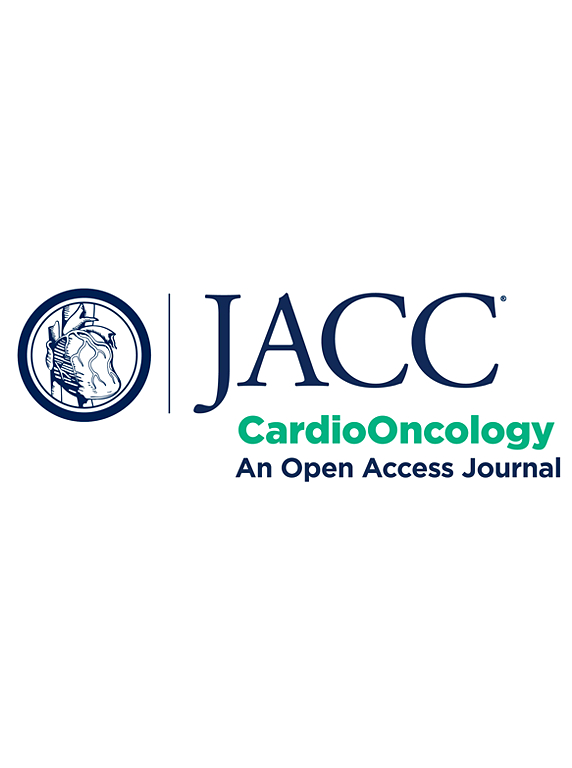表观遗传年龄加速介导儿童癌症幸存者心脏代谢和心血管风险的治疗效果。
IF 12.8
1区 医学
Q1 CARDIAC & CARDIOVASCULAR SYSTEMS
引用次数: 0
摘要
背景:由于先前的基因毒性治疗,儿童癌症幸存者发生表观遗传年龄加速(EAA)和随后的发病率(包括心脏代谢危险因素(CMRFs)和心血管疾病)的风险增加。目的:探讨EAA在癌症治疗暴露与CMRFs及心血管疾病风险之间的中介作用。方法:本研究包括来自St. Jude终身队列的2939名5年幸存者,他们使用外周血单个核细胞进行DNA甲基化分析。EAA采用三种已建立的表观遗传时钟:DunedinPACE、PCPhenoAge和GrimAge2来计算。治疗数据,包括身体区域特异性放疗(RT)和化疗药物,如蒽环类药物和皮质类固醇,从医疗记录中提取。结果包括3个CMRFs(糖代谢异常、高血压和肥胖)和2个心血管疾病(心肌病和心肌梗死)。进行中介分析以量化EAA在每种治疗暴露与每种临床结果之间的关联中的介导程度。结果:EAA部分介导了腹部RT与糖代谢异常的关联(DunedinPACE: 35.4%;grimag2: 16.2%),腹部放疗(DunedinPACE: 25.9%)或蒽环类药物(DunedinPACE: 12.5%)和高血压之间,皮质类固醇和肥胖(DunedinPACE: 8.6%)之间。EAA还介导了心脏RT和心肌病之间的关联(PCPhenoAge: 30.3%;DunedinPACE: 19.9%;GrimAge2: 14.4%)和心肌梗死(PCPhenoAge: 24.1%;DunedinPACE: 15.5%;GrimAge2: 13.2%),以及蒽环类药物和心肌病(GrimAge2: 6.0%;PCPhenoAge: 5.2%;DunedinPACE: 3.9%)。结论:EAA在癌症治疗暴露与CMRFs和心血管疾病风险之间的关联中占很大比例。这些发现为生物衰老作为一种潜在的机制途径提供了见解,并支持开发针对加速衰老的干预措施,以减轻长期治疗相关的毒性,并降低这一高危人群的过早死亡率。本文章由计算机程序翻译,如有差异,请以英文原文为准。
Epigenetic Age Acceleration Mediates Treatment Effects on Cardiometabolic and Cardiovascular Risk in Childhood Cancer Survivors
Background
Childhood cancer survivors are at increased risk for epigenetic age acceleration (EAA) and subsequent morbidities, including cardiometabolic risk factors (CMRFs) and cardiovascular diseases, because of prior genotoxic treatments.
Objectives
The aim of this study was to evaluate the mediating role of EAA in the relationship between cancer treatment exposures and risk for CMRFs and cardiovascular diseases.
Methods
This study included 2,939 5-year survivors from SJLIFE (St. Jude Lifetime Cohort) who underwent DNA methylation profiling using peripheral blood mononuclear cells. EAA was calculated using 3 established epigenetic clocks: DunedinPACE, PCPhenoAge, and GrimAge2. Treatment data, including body region–specific radiotherapy (RT) and chemotherapeutic agents such as anthracyclines and corticosteroids, were abstracted from medical records. Outcomes included 3 CMRFs (abnormal glucose metabolism, hypertension, and obesity) and 2 cardiovascular diseases (cardiomyopathy and myocardial infarction). Mediation analysis was conducted to quantify the extent to which EAA mediated the association between each treatment exposure and each clinical outcome.
Results
EAA partially mediated the associations between abdominal RT and abnormal glucose metabolism (DunedinPACE 35.4%, GrimAge2 16.2%), between abdominal RT (DunedinPACE 25.9%) or anthracyclines (DunedinPACE 12.5%) and hypertension, and between corticosteroids and obesity (DunedinPACE 8.6%). EAA also mediated the associations between heart RT and cardiomyopathy (PCPhenoAge 30.3%, DunedinPACE 19.9%, GrimAge2 14.4%) and myocardial infarction (PCPhenoAge 24.1%, DunedinPACE 15.5%, GrimAge2 13.2%), and anthracyclines and cardiomyopathy (GrimAge2 6.0%, PCPhenoAge 5.2%, DunedinPACE 3.9%).
Conclusions
EAA accounted for a substantial proportion of the association between cancer treatment exposures and risk for CMRFs and cardiovascular diseases. These findings provide insight into biological aging as a potential mechanistic pathway and support the development of interventions targeting accelerated aging to mitigate long-term treatment-related toxicities and reduce premature mortality in this high-risk population.
求助全文
通过发布文献求助,成功后即可免费获取论文全文。
去求助
来源期刊

Jacc: Cardiooncology
Multiple-
CiteScore
12.50
自引率
6.30%
发文量
106
期刊介绍:
JACC: CardioOncology is a specialized journal that belongs to the esteemed Journal of the American College of Cardiology (JACC) family. Its purpose is to enhance cardiovascular care for cancer patients by publishing high-quality, innovative scientific research and sharing evidence-based knowledge.
The journal aims to revolutionize the field of cardio-oncology and actively involve and educate professionals in both cardiovascular and oncology fields. It covers a wide range of topics including pre-clinical, translational, and clinical research, as well as best practices in cardio-oncology. Key areas of focus include understanding disease mechanisms, utilizing in vitro and in vivo models, exploring novel and traditional therapeutics (across Phase I-IV trials), studying epidemiology, employing precision medicine, and investigating primary and secondary prevention.
Amyloidosis, cardiovascular risk factors, heart failure, and vascular disease are some examples of the disease states that are of particular interest to the journal. However, it welcomes research on other relevant conditions as well.
 求助内容:
求助内容: 应助结果提醒方式:
应助结果提醒方式:


